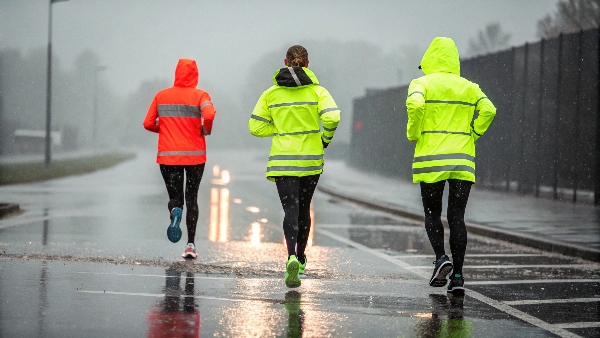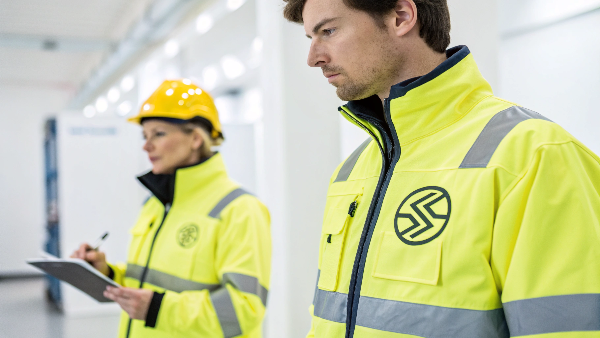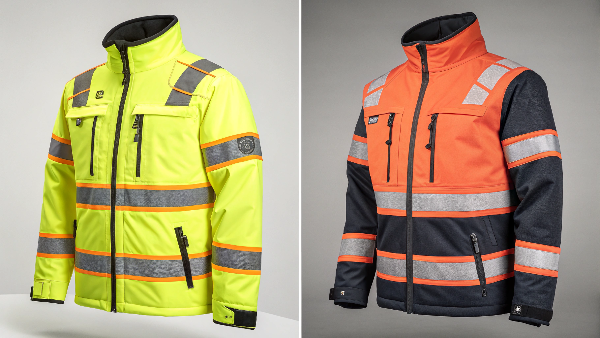Worried about worker safety in low light conditions? Accidents involving vehicles or equipment are serious risks on many job sites. High-visibility clothing helps drivers and operators see workers clearly, preventing tragic incidents and keeping your team safe.
High-visibility clothing uses bright fluorescent colors for daytime visibility and retroreflective tapes for nighttime. This makes workers stand out against complex backgrounds, significantly reducing accident risks by increasing how easily and quickly they are seen. It improves overall worksite safety.

Seeing the benefits is one thing, but maybe you still wonder how effective this gear really is. Let's explore that further. Understanding the details helps you make the best safety choices for your people and your business.
How effective is high-visibility clothing1?
Do you wonder if hi-vis gear really makes a difference on the job site? Investing in safety equipment without proof feels risky. Properly certified hi-vis clothing is proven to make wearers significantly more visible, helping prevent accidents.
High-visibility clothing is very effective. Studies show fluorescent materials2 boost daytime visibility, especially at dawn and dusk. Retroreflective tape drastically increases nighttime detection under headlights. Compliant garments significantly reduce "struck-by" incidents by making workers noticeable much sooner.
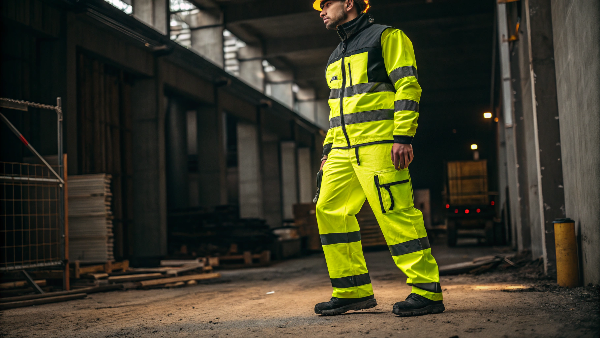
The effectiveness comes from two key features working together: fluorescence and retroreflection. Fluorescence is key during daylight hours. These bright colors absorb invisible ultraviolet (UV) light and re-emit it as visible light. This makes the clothing appear much brighter than ordinary colors, especially helpful during twilight hours or in foggy conditions. Retroreflective materials are crucial at night. They don't just scatter light; they bounce light directly back towards the original source, like a car's headlights. This means the driver sees a bright, clear reflection of the worker, not just a faint shape.
Think about the contrast. A worker wearing dark clothes on a road at night is nearly invisible until it's too late. But a worker wearing certified hi-vis gear stands out sharply against the dark background. This difference is critical.
Standards like ANSI/ISEA 107 (common in the US) and EN ISO 20471 (used in Europe) set strict requirements to ensure effectiveness. These standards specify:
- Color: Only certain bright fluorescent yellows, oranges, or reds are allowed because they are most visible to the human eye against most backgrounds.
- Reflectivity: Minimum performance levels are set for the retroreflective tape3s, ensuring they work well from various angles and distances.
- Coverage: Minimum surface areas of both fluorescent and reflective materials are required, depending on the garment's class (more on classes later).
Following these standards ensures the clothing performs as intended. Here's a simple comparison:
| Condition | Clothing Type | Estimated Detection Distance (Approx.) |
|---|---|---|
| Daytime (Clear) | Normal Clothes | 50 meters |
| Daytime (Clear) | Fluorescent Hi-Vis | >200 meters |
| Night (Headlights) | Dark Clothes | 15 meters |
| Night (Headlights) | Hi-Vis (Reflective) | >150 meters |
This huge difference in detection distance gives drivers and equipment operators vital extra seconds to react. That's the core of its effectiveness – providing time to prevent a collision. As a manufacturer since 2007, we at Vissafety ensure our materials meet these demanding standards.
What is the OSHA standard for high-visibility clothing?
Navigating safety regulations like those from OSHA can be confusing. Are there specific OSHA rules for hi-vis gear? Getting compliance wrong means potential fines and, more importantly, puts workers at unnecessary risk on the job.
OSHA doesn't have its own unique design standard for hi-vis clothing. But, OSHA regulation 29 CFR 1926.651(d)4 requires workers exposed to vehicle traffic wear it. OSHA often references the ANSI/ISEA 107 standard5 as a way to meet this requirement effectively.
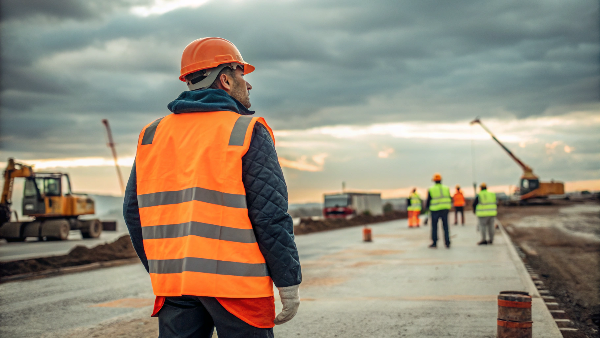
While OSHA doesn't publish its own detailed design specifications like ANSI does, it clearly mandates the use of high-visibility garments in certain hazardous situations. The most frequently cited rule is within the construction standards, specifically 29 CFR 1926.651(d), which applies to excavation work. It states workers exposed to vehicular traffic must wear warning vests or other suitable garments marked with or made of reflectorized or high-visibility material.
Furthermore, the Federal Highway Administration (FHWA) has a rule (23 CFR Part 634) that applies to workers within the right-of-way of Federal-aid highways. This rule requires workers to wear high-visibility safety apparel (HVSA) that meets the ANSI/ISEA 107 standard, specifically Performance Class 2 or Class 3. OSHA often enforces its requirements by pointing to compliance with this FHWA rule or by recognizing the ANSI/ISEA 107 standard5 itself as the accepted industry practice for adequate visibility.
What does this mean for employers in the US?
- Meeting Requirements: Using apparel certified to the ANSI/ISEA 107 standard is the most reliable way to ensure you meet OSHA's expectations for worker visibility near traffic.
- General Duty Clause: Even if a specific standard doesn't seem to apply, OSHA's General Duty Clause (Section 5(a)(1)) requires employers to provide a workplace "free from recognized hazards." Low visibility around moving vehicles or equipment (like forklifts in a warehouse or trucks in a yard) is definitely a recognized hazard. So, providing hi-vis gear is often necessary under this general rule too.
- State Variations: Remember that some states operate their own OSHA-approved safety programs. These state plans might have slightly different or more specific requirements for high-visibility apparel. It's always best to check your local regulations.
At Vissafety, we design and manufacture our high-visibility clothing for the North American market to meet or exceed the ANSI/ISEA 107 specifications. This helps our clients, like importers and distributors such as Danny Cheng in California, confidently provide compliant gear to their customers, ensuring they meet OSHA expectations.
What is the most important reason for a high-visibility apparel policy?
Implementing company policies takes time and effort. Is creating a formal policy for high-visibility clothing really necessary? Without clear rules, usage can be inconsistent, potentially weakening your safety efforts and leaving gaps in protection.
The single most important reason for a high-visibility apparel policy is preventing worker injuries and fatalities6 caused by being struck by vehicles or moving equipment. It's about saving lives and ensuring workers return home safe each day. Other benefits follow from this core goal.
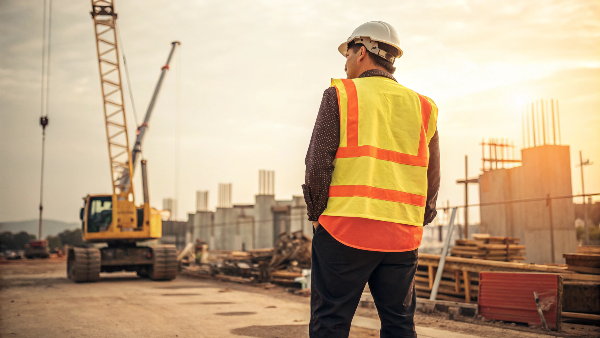
While compliance and reducing company liability are certainly important business reasons, the number one priority must always be the safety and well-being of the people doing the work. "Struck-by" incidents, where a worker is hit by a vehicle or object, are consistently among the leading causes of serious injuries and deaths in high-risk industries like construction, road maintenance, and logistics. A high-visibility apparel policy7 is a direct, practical measure aimed squarely at reducing this specific, severe hazard.
Beyond this fundamental reason of saving lives, a formal policy provides several other key advantages:
- Ensures Compliance: A written policy clearly documents how the company meets relevant regulations from bodies like OSHA and the FHWA. This is crucial during inspections or investigations.
- Reduces Liability: Demonstrating that you have a clear, consistently enforced policy helps protect the company legally if an incident does occur. It shows you took reasonable steps to protect workers.
- Sets Clear Expectations: Everyone in the workplace – employees, supervisors, subcontractors, and even visitors – knows exactly when and where hi-vis apparel must be worn. This removes ambiguity and potential arguments.
- Strengthens Safety Culture: Implementing and enforcing safety policies shows a genuine company commitment to worker health and safety. This builds trust and encourages employees to take all safety rules more seriously.
- Standardizes Protection: A policy ensures the correct type and class of hi-vis garment is used for each specific task and level of risk, as determined by a hazard assessment. It avoids workers using inadequate gear.
- Manages Garment Condition: A good policy should also cover inspection, cleaning, and replacement schedules for hi-vis apparel. Garments lose effectiveness when faded, dirty, or damaged, so maintaining them is vital.
In essence, a policy turns the use of high-visibility clothing from a recommendation into a mandatory procedure for specific situations. It embeds this crucial safety practice into the daily work routine, ensuring consistent application, which is key to preventing tragic accidents.
What is the purpose of visibility clothing?
You see workers wearing bright vests and jackets on many job sites. Is it just part of a uniform, or does it do more? Thinking it's just for identification misses the critical safety function this gear performs every single day, often in dangerous conditions.
The primary purpose of visibility clothing is to make the wearer highly conspicuous. This means they are easily seen and recognized, especially in low light conditions or against visually cluttered backgrounds. This significantly reduces the risk of accidents involving vehicles or moving equipment.
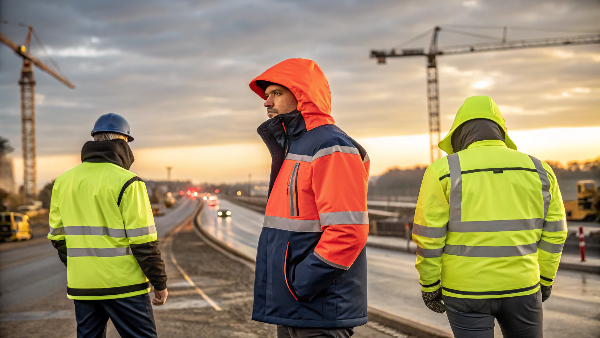
The main goal is conspicuity8 – making a person stand out clearly from their surroundings so they can be detected easily and quickly. Think of it as a passive visual warning signal worn by the individual. This is achieved through the specialized materials we discussed earlier:
- Fluorescent Material: This is most effective during daylight hours, particularly at dawn and dusk when natural light is low. The bright colors (usually yellow-green, orange-red, or red) appear unnaturally bright because they convert invisible UV light into visible light. This helps visually separate the worker from complex backgrounds like trees, buildings, or machinery.
- Retroreflective Material: This is essential for nighttime and very low-light conditions. Unlike materials that just reflect light diffusely, retroreflective tape bounces light directly back towards the source (e.g., a vehicle's headlights). This creates a very bright, distinct image of the worker for the driver, even at considerable distances.
The purpose isn't just about being seen eventually; it's about being seen in time for others to react safely. A driver of a car or the operator of heavy machinery needs enough advance warning to recognize the person, assess the situation, and then slow down, stop, or steer clear. High-visibility clothing provides this critical buffer of detection time.
This purpose is vital in many work environments:
- Road crews working inches away from fast-moving traffic.
- Warehouse staff navigating aisles with operating forklifts.
- Airport ground personnel moving around planes and service vehicles.
- Emergency responders managing chaotic scenes on highways.
- Construction workers operating alongside excavators, loaders, and haul trucks.
In all these scenarios, the environment presents significant visibility challenges. The purpose of the clothing is to overcome these challenges and keep the worker clearly detectable, drastically lowering the probability of a collision. It's a safety device designed for one crucial job: making people seen.
What are the 3 classes of high-visibility clothing?
You might notice that not all hi-vis vests or jackets look the same. Some have more reflective tape or brighter material than others. Does this design difference matter? Choosing the wrong type might mean a worker doesn't have enough visibility protection for their specific job risk.
The ANSI/ISEA 107 standard defines three classes based on the minimum required area of background (fluorescent) material and retroreflective material. Class 1 offers basic visibility for low-risk areas. Class 2 is for higher-risk areas with traffic. Class 3 provides the highest visibility.
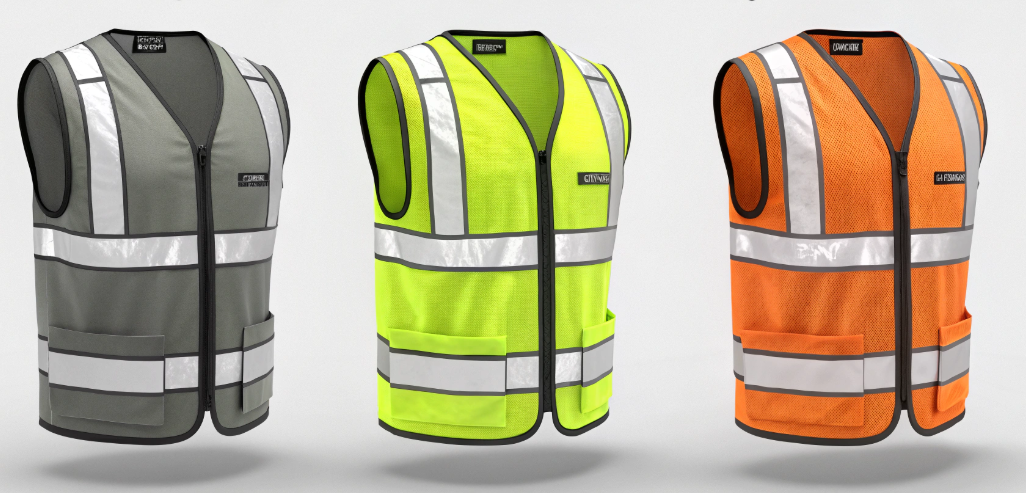
The ANSI/ISEA 107 standard, widely used in the United States for High-Visibility Safety Apparel (HVSA), categorizes garments into three performance classes. The main difference between the classes is the total area of high-visibility materials required on the garment. More material generally means greater conspicuity, especially from further distances and under poorer conditions. Employers must choose the appropriate class based on the anticipated hazards of the work environment, determined through a risk assessment.
Here’s a basic guide to the classes:
Performance Class 1:
- Visibility Level: Minimum required amount of high-visibility materials. Offers basic conspicuity.
- Intended Use: For workers in environments where vehicle traffic is slow (under 25 mph / 40 kph) and well separated from the work area. For tasks that allow full attention to traffic.
- Example Occupations: Parking lot attendants, warehouse workers away from vehicle paths, roadside "Adopt-a-Highway" litter cleanup crews.
- Typical Garments: Often simple vests.
Performance Class 2:
- Visibility Level: Moderate amount of high-visibility materials, offering superior visibility compared to Class 1. Requires more coverage on the torso.
- Intended Use: For workers who need greater visibility in poor weather or low light, or who work near roadways where traffic speeds exceed 25 mph. Tasks might divert some attention from traffic.
- Example Occupations: Roadway construction workers, utility crews, survey teams, railway workers, school crossing guards, airport ground crews, law enforcement managing traffic.
- Typical Garments: Vests, T-shirts, jackets. This is a very common class.
Performance Class 3:
- Visibility Level: Maximum amount of high-visibility materials, offering the highest level of conspicuity in complex environments or from long distances. Mandatory material on arms and/or legs (if trousers are worn).
- Intended Use: For workers facing serious hazards, exposed to high-speed traffic (over 50 mph / 80 kph), high-risk environments, or when the wearer must be conspicuous through a full range of body motions at a minimum of 1,280 feet (390 m). For work in extreme weather (hurricane, blizzard).
- Example Occupations: Highway maintenance crews, flaggers in high-speed zones, emergency responders on major highways, workers performing towing or recovery.
- Typical Garments: Jackets, coveralls, bib trousers, or ensembles (e.g., a Class 2 vest worn with Class E trousers creates a Class 3 ensemble).
Type Designation: ANSI/ISEA 107 also uses Type designations: Type O (Off-Road), Type R (Roadway), and Type P (Public Safety). These types specify requirements within the classes for particular work environments (e.g., Type R and P usually require Class 2 or 3).
Choosing the right class is not optional; it's a critical safety decision based on risk. Class 1 is never appropriate for roadway work. As manufacturers, we produce garments certified to all classes to meet diverse client needs.
Is high visibility clothing considered PPE?
We understand that hi-vis gear is crucial for safety, but does it officially count as 'Personal Protective Equipment' (PPE) in the same way as a hard hat or safety glasses? Uncertainty about its classification might affect how it's managed in purchasing, distribution, and safety protocols.
Yes, high-visibility clothing is absolutely considered Personal Protective Equipment (PPE). Its specific purpose is to protect the wearer from a recognized workplace hazard – the danger of not being seen by drivers or equipment operators, which could lead to serious injury or death.
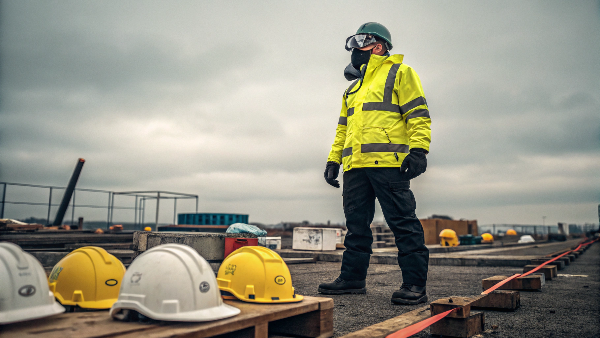
Let's look at the definition. Safety authorities like OSHA define Personal Protective Equipment (PPE) as equipment worn to minimize exposure to hazards that cause serious workplace injuries and illnesses. These hazards can be chemical, physical, electrical, mechanical, or other types found in the workplace.
High-visibility clothing fits this definition perfectly:
- The Hazard Identified: The danger is low visibility leading to the physical risk of being struck by a vehicle or moving machinery. This is a well-recognized and often fatal hazard in many industries.
- The Protection Provided: The clothing minimizes exposure to this hazard by using specialized materials (fluorescent and retroreflective) to make the wearer much more noticeable. This gives drivers and operators the necessary time to see and avoid the worker.
Unlike a standard company uniform, which might be primarily for branding or team identification, high-visibility clothing has a specific, regulated safety function defined by standards like ANSI/ISEA 107 or EN ISO 20471. It's designed to perform a protective task.
Because it is classified as PPE, certain employer responsibilities typically apply under safety regulations like OSHA's:
- Hazard Assessment: Employers must assess the workplace to determine if visibility hazards exist that require the use of hi-vis apparel.
- Provision: If required, employers must generally provide this PPE to employees, often at no cost.
- Selection: The employer must select the appropriate type and class of hi-vis garment based on the specific hazards identified.
- Training: Workers must be trained on why the PPE is necessary, when to use it, how to wear and adjust it correctly, how to care for it, and its limitations.
- Maintenance: The PPE must be maintained in a clean and reliable condition to ensure it continues to provide the intended protection. Worn-out or damaged hi-vis gear must be replaced.
Treating high-visibility clothing as essential PPE reinforces its critical role in your safety program. It's not just bright clothing; it’s a piece of life-saving equipment, just as important as other mandated safety gear.
When must high visibility clothing be worn?
Okay, we've established that hi-vis gear is vital PPE. The next logical and critical question is: when exactly must workers wear it? Making assumptions or guessing about requirements can lead to non-compliance with regulations and dangerously expose workers to risk.
High-visibility clothing must be worn whenever workers are exposed to potential hazards from moving vehicles or equipment, especially in situations with low light, bad weather, or complex backgrounds where they might not be easily seen. Specific regulations mandate it for many roadway and construction tasks.
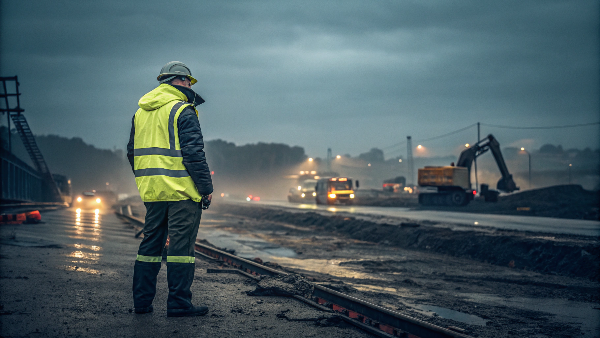
The need to wear high-visibility clothing is determined by the risk present in the work environment. While regulations set minimum requirements for certain jobs, a thorough hazard assessment for each specific worksite and task is the best way to ensure proper protection.
Here are common situations where wearing high-visibility apparel is typically required or strongly recommended:
- Working Near Roadways: This is perhaps the most common requirement. Anyone working on or adjacent to public roads, highways, or streets, particularly where traffic speeds are higher or work occurs close to traffic lanes. This includes:
- Road construction and paving crews
- Flaggers directing traffic
- Utility workers (power, water, telecom)
- Surveyors
- Emergency responders (police, fire, EMS) at accident scenes
- Towing and recovery operators
- Construction Sites: Workers who are on foot and exposed to moving vehicles like trucks, dumpers, graders, excavators, cranes, etc. This applies even within the site boundaries, not just near public roads.
- Warehouses and Distribution Centers: Employees working in areas where forklifts, pallet jacks, or delivery trucks operate. Loading docks are particularly high-risk areas.
- Airports: Ground crews working on the tarmac, ramps, and baggage handling areas near moving aircraft and service vehicles.
- Any Work in Low Light or Poor Visibility: Regardless of the location, any task performed during:
- Nighttime hours
- Dawn or dusk (twilight)
- Heavy rain, fog, snow, or blizzard conditions
These conditions significantly reduce a driver's ability to see workers in normal clothing.
Key Factors Driving the Need:
- Speed of Vehicles/Equipment: Higher speeds require greater visibility distance (meaning higher Class garments are needed).
- Proximity to Hazard: How close must the worker be to moving traffic or machinery?
- Work Zone Complexity: Busy, visually cluttered environments make it harder to spot workers.
- Worker Attention: Is the worker's task likely to distract them from monitoring their surroundings?
If your risk assessment identifies a potential hazard where a worker might not be seen by someone operating a vehicle or machine, then high-visibility PPE is necessary. The specific conditions will also dictate which ANSI/ISEA Class (1, 2, or 3) or Type (O, R, P) is appropriate for adequate protection.
Conclusion
In summary, high-visibility clothing is crucial Personal Protective Equipment. It dramatically increases how easily workers are seen, directly preventing accidents and saving lives in potentially hazardous work environments. Always choose the right type and class for the job.
-
Explore this link to understand how high-visibility clothing enhances safety and reduces accidents on job sites. ↩
-
Learn about the science behind fluorescent materials and their role in enhancing visibility, especially in low-light conditions. ↩
-
Discover how retroreflective tape functions to increase nighttime visibility, making it essential for worker safety. ↩
-
This regulation outlines essential requirements for high-visibility clothing in construction, vital for worker safety. ↩
-
Understanding the ANSI/ISEA 107 standard is crucial for ensuring compliance with OSHA regulations regarding worker visibility. ↩ ↩
-
Explore this resource to understand how preventing worker injuries can save lives and enhance workplace safety. ↩
-
This link will provide insights into the significance of high-visibility apparel policies in ensuring worker safety and compliance. ↩
-
Learn how conspicuity plays a vital role in safety, especially in hazardous environments, to prevent accidents and save lives. ↩

